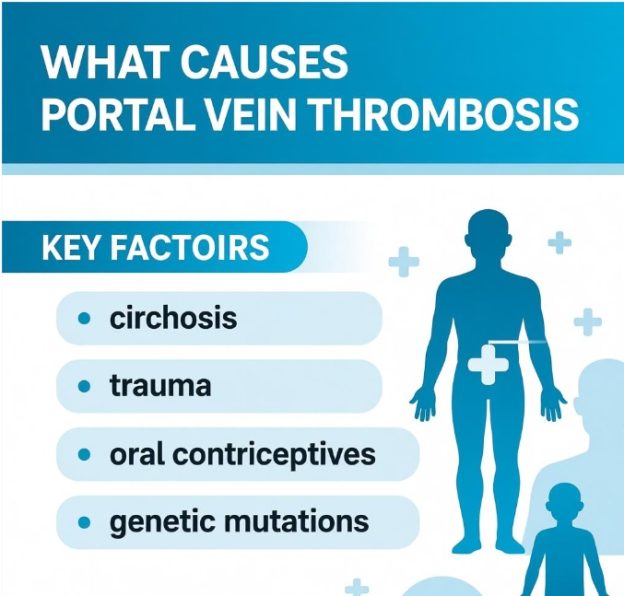Portal vein thrombosis (PVT) is the partial or complete occlusion of the portal venous system by thrombus. Presentation is determined by the tempo of obstruction (acute vs. chronic), the extent of mesenteric involvement, and the presence of underlying cirrhosis or malignancy. Symptoms range from incidental imaging findings to life-threatening intestinal ischemia.
- Abdominal pain
Colicky or constant upper-abdominal discomfort is the commonest early feature, reported in up to 90 % of acute cases. Pain may be non-specific, but when disproportionate to physical signs it heralds mesenteric vein extension and impending bowel infarction . - Fever and systemic inflammatory response
Low-grade pyrexia, rigors, and elevated C-reactive protein are frequent even in the absence of documented bacteraemia, reflecting thrombus-induced inflammation . - Ascites
New-onset, usually small-volume ascites develops in ~50 % of acute non-cirrhotic cases, secondary to sinusoidal hypertension and fluid extravasation; tense ascites suggests extensive thrombosis or intestinal ischemia . - Gastrointestinal bleeding
Haematemesis, melaena, or rectal bleeding occur when thrombosis aggravates pre-existing portal hypertension, producing oesophageal, gastric, or choledochal varices. Bleeding is the presenting event in up to 40 % of chronic cases and carries a higher mortality when superimposed on cirrhosis . - Splenomegaly and hypersplenism
Acute venous congestion enlarges the spleen; thrombocytopenia or leucopenia may appear within days. Persistent splenomegaly indicates chronic portal hypertension and cavernous transformation . - Intestinal ischaemia
Extension into the superior mesenteric vein produces diarrhoea, haematochezia, rebound tenderness, and ileus. Persistent lactic acidosis, rising lactate, or multi-organ dysfunction signals bowel infarction and mandates emergency intervention . - Hepatic encephalopathy (rare)
Acute shunting of nitrogenous products through collaterals can precipitate confusion, asterixis, and coma even in the absence of underlying cirrhosis. - Chronic portal hypertension sequelae
After cavernoma formation, patients may remain asymptomatic for years, but long-term risks include repeated variceal bleeding, ascites, and portal cholangiopathy with cholestasis or cholangitis .
| Symptom / Sign | Typical Presentation |
|---|---|
| Abdominal pain | Colicky or constant, may herald mesenteric extension |
| Fever | Low-grade, rigors, elevated CRP |
| Ascites | New, small-volume; tense if ischaemia present |
| GI bleeding | Haematemesis/melaena from varices |
| Splenomegaly | Acute congestion or chronic hypersplenism |
| Intestinal ischaemia | Diarrhoea, haematochezia, rebound tenderness |
| Hepatic encephalopathy | Confusion, asterixis (rare, acute) |
| Chronic sequelae | Recurrent bleeding, ascites, cholangitis |
